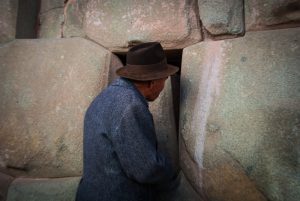Cuzco’s Inca Heritage Faces Severe Threats

The massive stones of Cuzco, arranged like complex puzzles, one on another seem eternal. Nevertheless, a ruling by Judge Marina Inés Supanta points out their fragility as Cuzco grows, draws more tourists, and modernizes.
Judge Supana sentenced the owners of the new shopping complex, Centro Comercial Ima Sumaq to a suspended sengence of four years in prison for destruction of an Inca wall on Loreto Street, a narrow, Inca-style street which once connected the Plaza de Armas with the Temple of the Sun, the Qoricancha. Once taken down and the stones broken, the wall is not restorable and the remains of the greatest Inca city ever are irremediably lost.

Besides the owners, Judge Supana also sentences the supervisor of the construction, Grover Miranda, and the ex-director of the National Institute of Culture (INC) (the governmental agency responsible for maintaining the cultural heritage, especially remnants of the Inca past, Jorge Zegarra Blacázar.
Cuzco is not alone in suffering the destruction of its colonial and pre-Columbian past. In July this year the Peruvian press filled with the news that a real estate development company had destroyed an entire pyramid overnight in the El Paraiso Huaca complex with construction machinery. They attempted to destroy three other pyramids. The site was disputed between developers and the INC and was a site that went to the early stages of state formation in Peru, some four to ficve thousand years ago.

Although a difficulty throughout Peru where development needs conflict with those of preserving the nation’s heritage and understanding its great civilizations, in Cuzco the problem is particularly acute.

In Cuzco the problem is particularly intense. Arquelogía del Perú reports that the owners of the Hotels Terravida and Terra dug basements for their hotels, implying they destroyed archeological remains in the process. The construction of basements is prohibited according to the master plan of the monumental core of Cuzco. The hotels are located on Suecia Street and Plateros Street respectively.

In today’s Cuzco rumors about that the construction of the new Marriott Hotel also led to massive damage of Inca and potentially preInca remains. People speak of artifacts being dumped surreptitiously in the river by night and wonder how much money was paid to the INC and other political leaders to allow the construction. Despite the strong rumors no charges have been brought as far as we know.
The Marriott Hotel depends on a massive extension underground that required substantial digging.
Similar rumors of destruction of Inca patrimony were made about the Novotel when it was built some years ago.
Cuzco faces constant pressures from powerful interests due to tourism and the demands of local people for modern services and housing.

Nevertheless, Cuzco was the seat of the Inca Empire. Even with the destruction, which has been going on since the Spanish arrived, it remains an amazing Inca site. It may not be isolated and intact as Machu Picchu or Choquequirao, but it like Rome maintains monuments and structures of immense architectural and historical value.




